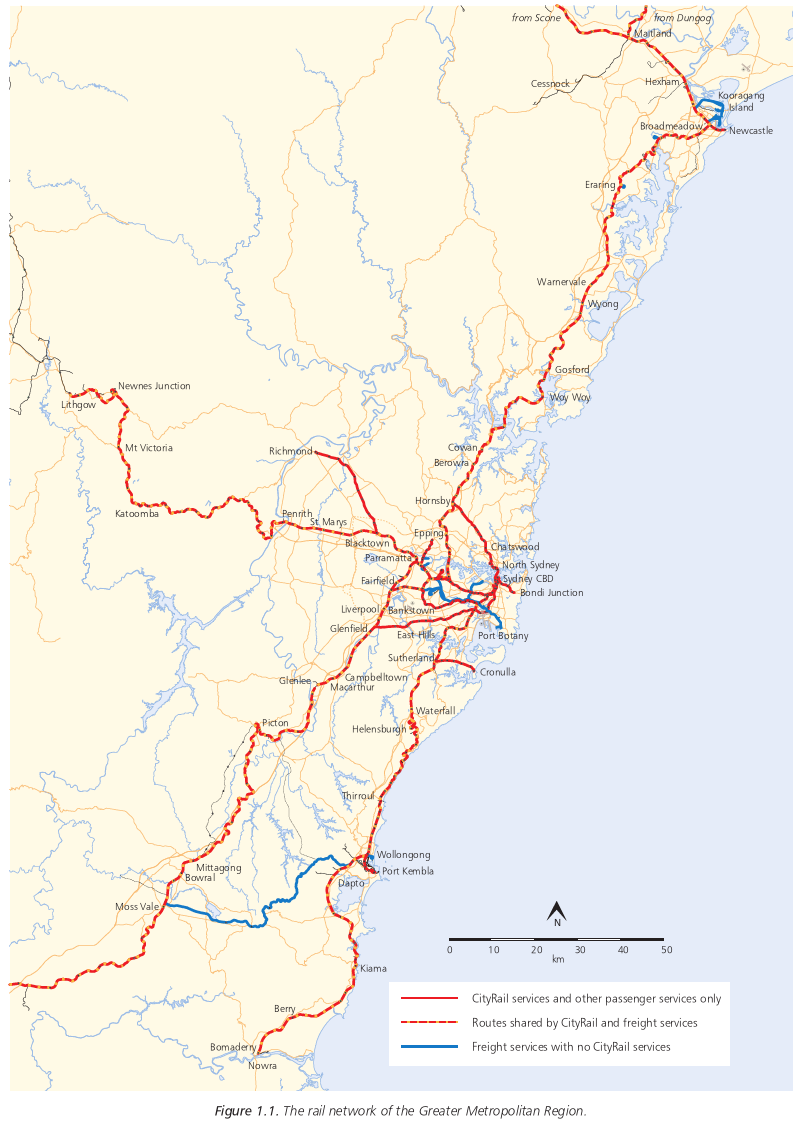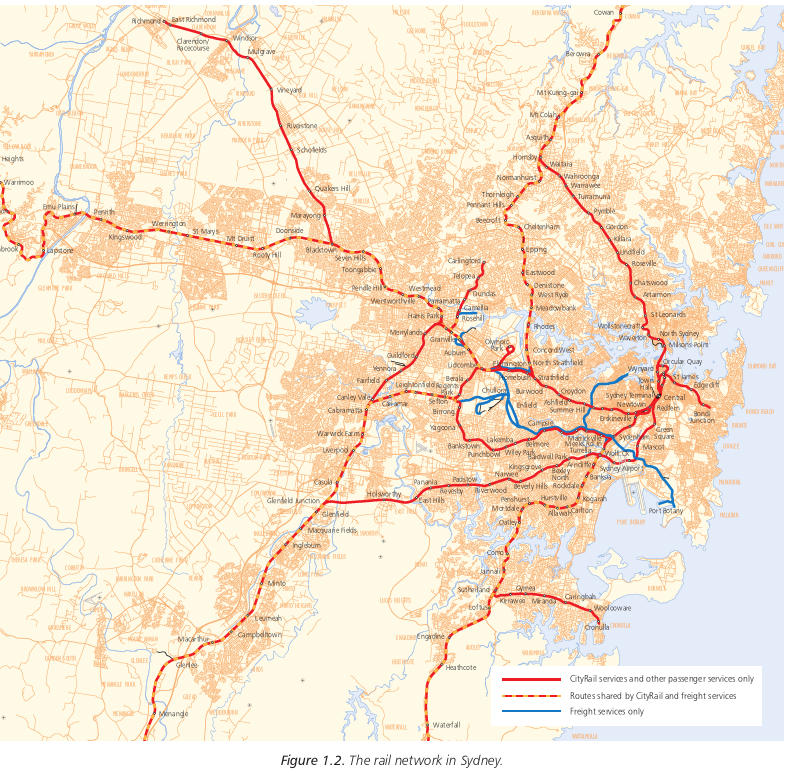

This report provides a high-level overview of an integrated Long-Term Strategic Plan for Rail for Sydney, the Central Coast, Newcastle, the Illawarra, the South Coast and the Blue Mountains (Figures 1.1 and 1.2), developed by the Office of the Co-ordinator General of Rail with the assistance of the State Rail Authority, Rail Infrastructure Corporation and Department of Transport.
The Long-Term Strategic Plan for Rail, the preparation of which was agreed to by the Budget Committee of Cabinet on 30 November 2000, sets out:
The starting basis for the Long-Term Strategic Plan for Rail is the Government's 1998 transport strategy Action for Transport 2010, which in particular foreshadowed:
In doing so, the Long-Term Strategic Plan for Rail's consideration of what is required for metropolitan passenger rail services is driven by pragmatic analyses by State Rail of its own needs, both as the sole operator of suburban and intercity passenger services in the metropolitan region -- and thus the only client of this type of the rail infrastructure owner and maintainer, Rail Infrastructure Corporation, in the region -- and as the organisation now legally responsible for all timetabling and the control of all passenger and freight train movements on the metropolitan rail network.
This approach can be contrasted with past proposals for rail infrastructure capital works and maintenance, which were driven more by (a) serious shortfalls in available funding and (b) the interests and analyses of Rail Infrastructure Corporation's predecessors, and thus had much less regard to State Rail needs. This often produced priorities (such as a downgrading of major periodic maintenance of rail infrastructure assets) which were different to State Rail's, and contributed to the degradation of CityRail service quality in the last few years.
Rail Infrastructure Corporation should continue to be the prime
driver of metropolitan freight rail infrastructure planning, provided
these plans reflect the real needs of rail freight operators, but
again the resultant infrastructure plans should take full account of
the needs of State Rail as the major rail operator in the region (for
example, through the sharing of new lines where this maximises the
overall benefits and/or
there is insufficient space for separate freight and passenger
tracks).


The change in emphasis to have the metropolitan passenger rail planning process and metropolitan train control planning process driven by State Rail's needs is both fundamental and essential.
The other fundamental change in the Long-Term Strategic Plan for Rail, compared with previous annually presented proposals by the rail agencies for metropolitan rail system capital works and maintenance only over the next year or two, is that it sets out quite detailed five-year and ten-year plans, plus more indicative plans for the following decade and a long-term conceptual framework, so that:
In some instances the analyses carried out since Action for Transport 2010 was released now point to a reordering of priorities, with a greater emphasis on reliability and capacity improvements before some (but not all) of the more ambitious projects proceed.
In most of these cases, the analyses have essentially shown that other works, focussed more on reliability and capacity, are pre-requisites for the Action for Transport projects now suggested for short-term to medium-term deferral.
For example, the original objectives of several Action for Transport projects will simply not be able to be achieved unless capacity-enhancement projects in other areas already subject to severe congestion, especially the inner city, are completed first.
In other cases, the new analyses have suggested that demand in the relevant corridor(s) is unlikely to increase as rapidly as previously assumed, while demand growth in other corridors may well be -- and often already is -- much faster.
At the same time, the new analyses have permitted the development of a more coherent long-term view of a possible "ultimate" form of a greater metropolitan rail system, serving the multiple social, economic, employment and educational access and other transport needs of a metropolis of (perhaps) six million people.
This provides an essential long-term but non-prescriptive context for all rail development proposals, in much the same way as long-term regional and corridor plans have guided road network development over the last 55 years.
Among other things, it allows a greater understanding of the potential "ultimate" roles of rail infrastructure and services developed for short-term and medium-term purposes over the next 15-20 years, and should assist the Government in:
Section 2 of this overview report very briefly summarises current passenger and freight rail transport operations and constraints in the greater metropolitan region, including the factors determining the safety, reliability, efficiency and overall quality of current CityRail services.
Section 3 provides a similarly brief overview of the factors directly affecting the shape of future rail transport in the region over the next 10-20 years, including future passenger and freight demand and the requirements imposed by the need for improved operational safety, reliability and efficiency.
Section 4 draws these threads together to set realistic short-term and medium-term objectives and service quality standards and then to analyse, on a corridor by corridor basis and on an "operational sector" basis,
Section 5 presents a longer-term perspective, outlining a vision of the possible "ultimate" greater metropolitan rail network, serving a metropolis of (perhaps) 5-6 million people.
Section 6 summarises, for the whole of the greater metropolitan network, strategies and timeframes for the essential replacement, augmentation and upgrading of CityRail's ageing suburban and intercity train fleets in line with the requirements summarised in sections 4 and 5.
It is emphasised that this report is only a high-level summary of a
much more detailed report. For further information on any of the
issues presented in this report, readers should refer to the full
Long-Term Strategic Plan for Rail report.